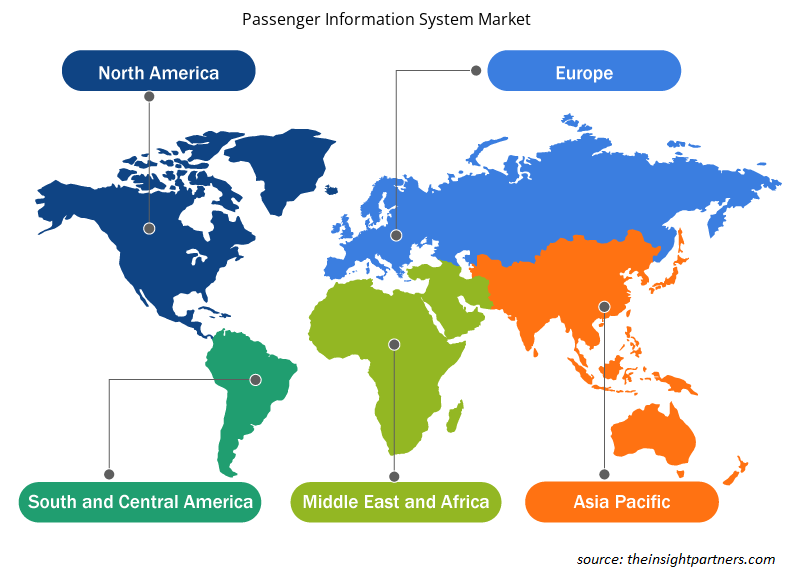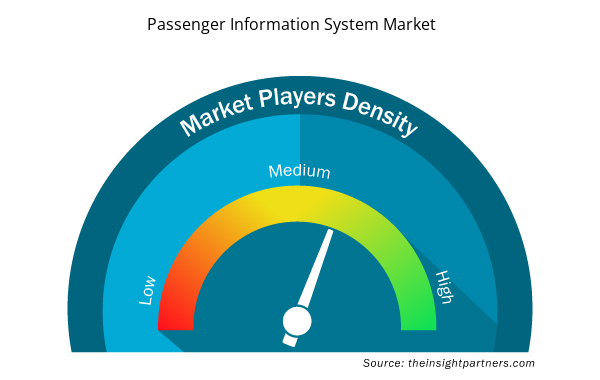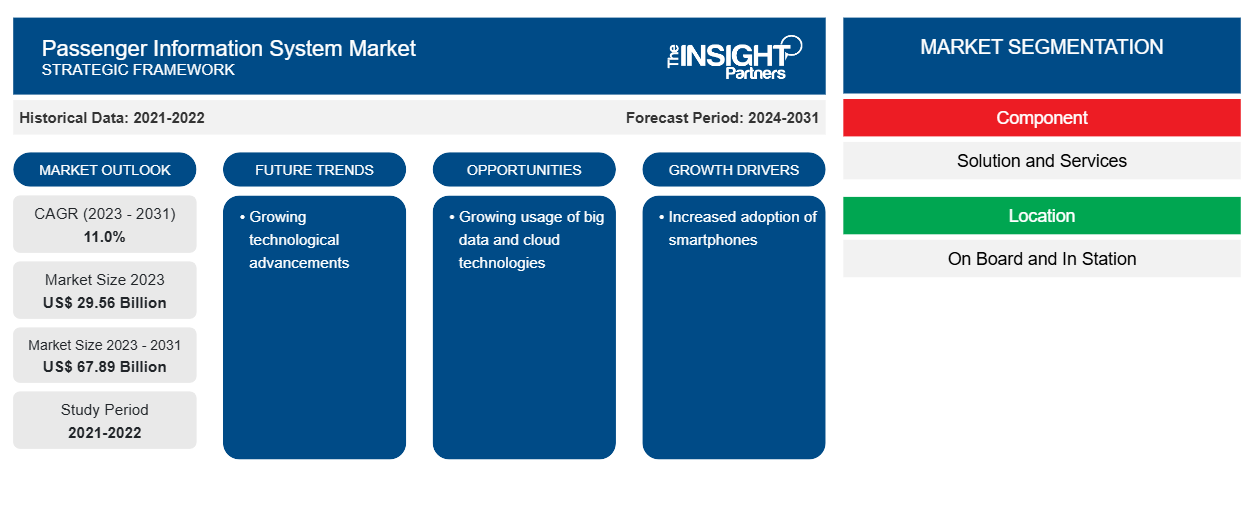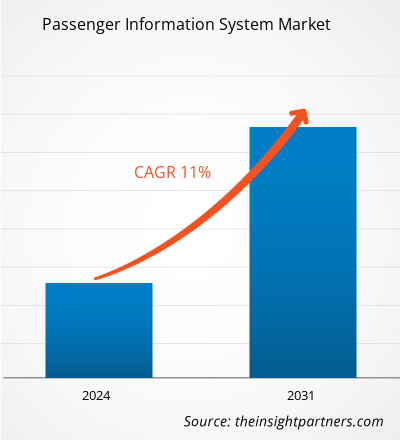旅客情報システム市場の規模は、2023 年の 295.6 億米ドルから 2031 年には 678.9 億米ドルに達すると予測されています。市場は 2023 年から 2031 年にかけて 11.0% の CAGR を記録すると予想されています。技術の進歩の拡大は、旅客情報システム市場の主要なトレンドであり続けると思われます。
旅客情報システム市場分析
旅客情報システムの需要は、航空交通量の増加、インテリジェント交通システムの採用の増加、交通部門における IoT ソリューションの浸透の増加、リアルタイムの交通情報に対する旅客の需要の増加など、いくつかの要因の結果として増加しています。さらに、旅客情報システムの市場は、旅程計画から出発予定時刻の変動まで、あらゆる旅行関連情報の需要増加の恩恵を受けると予想されています。さらに、交通機関の間で顧客に優れた旅行体験を提供することに対する意識の高まりが、市場の拡大を促進すると予測されています。
旅客情報システム市場の概要
旅客情報システムの目的は、オーディオ、ビデオ、メディアデバイスを介して、輸送サービスの状態と種類に関する最新情報を乗客に提供することです。これは、ハードウェアとITコンポーネントの集合体で構成されています。また、ニュースやエンターテイメントサービス、到着と出発の予想時刻の詳細も提供し、これらすべてが旅行体験の向上に貢献します。旅客情報システム市場は、交通機関が乗客に正確で信頼性の高いリアルタイムの輸送情報を提供する必要性が高まっているため拡大しています。さらに、より迅速なデータ転送機能を可能にする通信業界の発展、輸送部門でのIoT採用の急増、インテリジェント輸送システムに対する需要の増加により、市場は拡大しています。
要件に合わせてレポートをカスタマイズする
このレポートの一部、国レベルの分析、Excelデータパックなど、あらゆるレポートを無料でカスタマイズできます。また、スタートアップや大学向けのお得なオファーや割引もご利用いただけます。
- このレポートの主要な市場動向を入手してください。この無料サンプルには、市場動向から見積もりや予測に至るまでのデータ分析が含まれます。
旅客情報システム市場の推進要因と機会
スマートフォンの普及率増加
スマートフォンの使用が増加しているため、モバイル アプリケーション ベースの乗客情報システムが急速に普及しています。さらに、交通機関は、顧客を引き付け、スマートフォン チャネルを介して迅速かつ正確なリアルタイム情報にアクセスできるようにするために、乗客情報システムのモバイル アプリケーションに注力しています。また、公共交通機関向けのマルチモーダル交通アプリケーションの台頭により、市場拡大のチャンスが生まれています。
ビッグデータとクラウド技術の利用拡大
特に鉄道会社は、クラウド コンピューティングを使用して、さまざまな交通手段を自動化しています。クラウド コンピューティング技術を使用して、乗客情報システムは付近のバスの所在を追跡します。到着時刻を決定し、バス停のリアルタイム情報システムに表示されます。クラウド技術とデータ分析ソリューションの活用は、リソースの効率的な割り当てと経済的な乗客人口の監視に貢献します。
旅客情報システム市場レポートのセグメンテーション分析
旅客情報システム市場分析の導出に貢献した主要なセグメントは、コンポーネント、場所、輸送モード、および機能モデルです。
- 乗客情報システム市場は、コンポーネントに基づいてソリューションとサービスに分かれています。ソリューションセグメントは、2023年に大きな市場シェアを占めました。
- 場所別に見ると、市場は車内と駅構内に分かれています。車内セグメントは2023年に市場で最大のシェアを占めました。
- 輸送モードの面では、市場は道路、鉄道、水路、航空に分かれています。2023年には道路セグメントが市場を支配しました。
- 機能モデル別に見ると、市場はマルチメディア ディスプレイ、オーディオ システム、コンピューティング システム、ネットワークおよび通信デバイス、ビデオ監視、コンテンツ管理システムに分類されます。
地域別旅客情報システム市場シェア分析
旅客情報システム市場レポートの地理的範囲は、主に北米、アジア太平洋、ヨーロッパ、中東およびアフリカ、南米/中南米の 5 つの地域に分かれています。北米は、旅客情報システムの世界市場を支配しています。さらに、予測期間中、北米市場はおそらく急速に拡大するでしょう。この分野での市場拡大を推進する主な要因は、北米の先進国および発展途上国における旅客情報システムの生産と消費の増加です。PIS は、最先端の技術と堅牢なネットワーク インフラストラクチャの使用率が著しく高い、最大の市場の 1 つと見なされています。この地域は、公共交通機関の利用増加や都市化の急速なペースなどの要素により、旅客情報システム市場の拡大に大きな影響を与えています。さらに、旅客情報システム サービスとソリューションの使用の増加が、その拡大を促進すると予想されます。これらすべての要因が、この地域の旅客情報システム市場の成長に貢献しています。
旅客情報システム市場の地域別分析
予測期間を通じて旅客情報システム市場に影響を与える地域的な傾向と要因は、Insight Partners のアナリストによって徹底的に説明されています。このセクションでは、北米、ヨーロッパ、アジア太平洋、中東およびアフリカ、南米および中米にわたる旅客情報システム市場のセグメントと地理についても説明します。

- 旅客情報システム市場の地域別データを入手
旅客情報システム市場レポートの範囲
| レポート属性 | 詳細 |
|---|---|
| 2023年の市場規模 | 295.6億米ドル |
| 2031年までの市場規模 | 678.9億米ドル |
| 世界のCAGR(2023年~2031年) | 11.0% |
| 履歴データ | 2021-2022 |
| 予測期間 | 2024-2031 |
| 対象セグメント | コンポーネント別
|
| 対象地域と国 | 北米
|
| 市場リーダーと主要企業プロフィール |
|
市場プレーヤーの密度:ビジネスダイナミクスへの影響を理解する
旅客情報システム市場は、消費者の嗜好の変化、技術の進歩、製品の利点に対する認識の高まりなどの要因により、エンドユーザーの需要が高まり、急速に成長しています。需要が高まるにつれて、企業は提供内容を拡大し、消費者のニーズを満たすために革新し、新たなトレンドを活用し、市場の成長をさらに促進しています。
市場プレーヤー密度とは、特定の市場または業界内で活動している企業または会社の分布を指します。これは、特定の市場スペースに、その規模または総市場価値と比較して、どれだけの競合相手 (市場プレーヤー) が存在するかを示します。
旅客情報システム市場で事業を展開している主要企業は次のとおりです。
- テレステ株式会社
- シーメンスAG
- タレスグループ
- キュービック株式会社
- インドラ・システマスSA
- アルストム
免責事項:上記の企業は、特定の順序でランク付けされていません。

- 旅客情報システム市場のトップキープレーヤーの概要を入手
旅客情報システム市場のニュースと最近の動向
旅客情報システム市場は、主要な企業出版物、協会データ、データベースを含む一次調査と二次調査後の定性的および定量的データを収集することによって評価されます。市場の動向の一覧は次のとおりです。
- 2021 年 1 月、Cubic Corporation は、現在の交通技術ポートフォリオを拡張するために、モビリティ、乗客、サービス プロバイダー、交通機関向けの完全に統合されたプラットフォーム スイート「UMO」を導入しました。UMO は、ユーザーが公共交通機関と民間交通機関の両方で旅行をスケジュールし、支払い、旅行の特典を獲得し、モビリティを向上させるための最新情報を受け取ることができる柔軟なツール スイートです。
(出典:キュービック株式会社、同社ウェブサイト)
- 2020年6月、Wabtec Corporationは、電車や地下鉄の乗客に清潔で健康的な環境を提供するために、「BlueFiIter」空気ろ過装置を導入しました。鉄道車両では、BlueFilterが汚染物質の90%以上を除去します。
(出典:ワブテック株式会社、同社ウェブサイト)
旅客情報システム市場レポートの対象範囲と成果物
「旅客情報システム市場の規模と予測(2021〜2031年)」レポートでは、以下の分野をカバーする市場の詳細な分析を提供しています。
- 対象範囲に含まれるすべての主要市場セグメントの世界、地域、国レベルでの市場規模と予測
- 市場の動向(推進要因、制約、主要な機会など)
- 今後の主な動向
- 詳細なPEST/ポーターの5つの力とSWOT分析
- 主要な市場動向、主要プレーヤー、規制、最近の市場動向を網羅した世界および地域の市場分析
- 市場集中、ヒートマップ分析、主要プレーヤー、最近の動向を網羅した業界の状況と競争分析
- 詳細な企業プロフィール
- 過去2年間の分析、基準年、CAGRによる予測(7年間)
- PEST分析とSWOT分析
- 市場規模価値/数量 - 世界、地域、国
- 業界と競争環境
- Excel データセット



Report Coverage
Revenue forecast, Company Analysis, Industry landscape, Growth factors, and Trends

Segment Covered
This text is related
to segments covered.

Regional Scope
North America, Europe, Asia Pacific, Middle East & Africa, South & Central America

Country Scope
This text is related
to country scope.
よくある質問
The global passenger information system market is expected to grow at a CAGR of 11.0 % during the forecast period 2023 - 2031.
Increased adoption of smartphones and growing usage of big data and cloud technologies are the major factors that propel the global passenger information system market.
Growing technological advancements are anticipated to play a significant role in the global passenger information system market in the coming years.
The key players holding majority shares in the global passenger information system market are Alstom, Cubic Corporation, Hitachi, Ltd., Indra, and Mitsubishi Electric Corporation.
The global passenger information system market is expected to reach US$ 67.89 billion by 2031.
Trends and growth analysis reports related to Technology, Media and Telecommunications : READ MORE..
The Insight Partners performs research in 4 major stages: Data Collection & Secondary Research, Primary Research, Data Analysis and Data Triangulation & Final Review.
- Data Collection and Secondary Research:
As a market research and consulting firm operating from a decade, we have published and advised several client across the globe. First step for any study will start with an assessment of currently available data and insights from existing reports. Further, historical and current market information is collected from Investor Presentations, Annual Reports, SEC Filings, etc., and other information related to company’s performance and market positioning are gathered from Paid Databases (Factiva, Hoovers, and Reuters) and various other publications available in public domain.
Several associations trade associates, technical forums, institutes, societies and organization are accessed to gain technical as well as market related insights through their publications such as research papers, blogs and press releases related to the studies are referred to get cues about the market. Further, white papers, journals, magazines, and other news articles published in last 3 years are scrutinized and analyzed to understand the current market trends.
- Primary Research:
The primarily interview analysis comprise of data obtained from industry participants interview and answers to survey questions gathered by in-house primary team.
For primary research, interviews are conducted with industry experts/CEOs/Marketing Managers/VPs/Subject Matter Experts from both demand and supply side to get a 360-degree view of the market. The primary team conducts several interviews based on the complexity of the markets to understand the various market trends and dynamics which makes research more credible and precise.
A typical research interview fulfils the following functions:
- Provides first-hand information on the market size, market trends, growth trends, competitive landscape, and outlook
- Validates and strengthens in-house secondary research findings
- Develops the analysis team’s expertise and market understanding
Primary research involves email interactions and telephone interviews for each market, category, segment, and sub-segment across geographies. The participants who typically take part in such a process include, but are not limited to:
- Industry participants: VPs, business development managers, market intelligence managers and national sales managers
- Outside experts: Valuation experts, research analysts and key opinion leaders specializing in the electronics and semiconductor industry.
Below is the breakup of our primary respondents by company, designation, and region:

Once we receive the confirmation from primary research sources or primary respondents, we finalize the base year market estimation and forecast the data as per the macroeconomic and microeconomic factors assessed during data collection.
- Data Analysis:
Once data is validated through both secondary as well as primary respondents, we finalize the market estimations by hypothesis formulation and factor analysis at regional and country level.
- Macro-Economic Factor Analysis:
We analyse macroeconomic indicators such the gross domestic product (GDP), increase in the demand for goods and services across industries, technological advancement, regional economic growth, governmental policies, the influence of COVID-19, PEST analysis, and other aspects. This analysis aids in setting benchmarks for various nations/regions and approximating market splits. Additionally, the general trend of the aforementioned components aid in determining the market's development possibilities.
- Country Level Data:
Various factors that are especially aligned to the country are taken into account to determine the market size for a certain area and country, including the presence of vendors, such as headquarters and offices, the country's GDP, demand patterns, and industry growth. To comprehend the market dynamics for the nation, a number of growth variables, inhibitors, application areas, and current market trends are researched. The aforementioned elements aid in determining the country's overall market's growth potential.
- Company Profile:
The “Table of Contents” is formulated by listing and analyzing more than 25 - 30 companies operating in the market ecosystem across geographies. However, we profile only 10 companies as a standard practice in our syndicate reports. These 10 companies comprise leading, emerging, and regional players. Nonetheless, our analysis is not restricted to the 10 listed companies, we also analyze other companies present in the market to develop a holistic view and understand the prevailing trends. The “Company Profiles” section in the report covers key facts, business description, products & services, financial information, SWOT analysis, and key developments. The financial information presented is extracted from the annual reports and official documents of the publicly listed companies. Upon collecting the information for the sections of respective companies, we verify them via various primary sources and then compile the data in respective company profiles. The company level information helps us in deriving the base number as well as in forecasting the market size.
- Developing Base Number:
Aggregation of sales statistics (2020-2022) and macro-economic factor, and other secondary and primary research insights are utilized to arrive at base number and related market shares for 2022. The data gaps are identified in this step and relevant market data is analyzed, collected from paid primary interviews or databases. On finalizing the base year market size, forecasts are developed on the basis of macro-economic, industry and market growth factors and company level analysis.
- Data Triangulation and Final Review:
The market findings and base year market size calculations are validated from supply as well as demand side. Demand side validations are based on macro-economic factor analysis and benchmarks for respective regions and countries. In case of supply side validations, revenues of major companies are estimated (in case not available) based on industry benchmark, approximate number of employees, product portfolio, and primary interviews revenues are gathered. Further revenue from target product/service segment is assessed to avoid overshooting of market statistics. In case of heavy deviations between supply and demand side values, all thes steps are repeated to achieve synchronization.
We follow an iterative model, wherein we share our research findings with Subject Matter Experts (SME’s) and Key Opinion Leaders (KOLs) until consensus view of the market is not formulated – this model negates any drastic deviation in the opinions of experts. Only validated and universally acceptable research findings are quoted in our reports.
We have important check points that we use to validate our research findings – which we call – data triangulation, where we validate the information, we generate from secondary sources with primary interviews and then we re-validate with our internal data bases and Subject matter experts. This comprehensive model enables us to deliver high quality, reliable data in shortest possible time.


 このレポートの無料サンプルを入手する
このレポートの無料サンプルを入手する